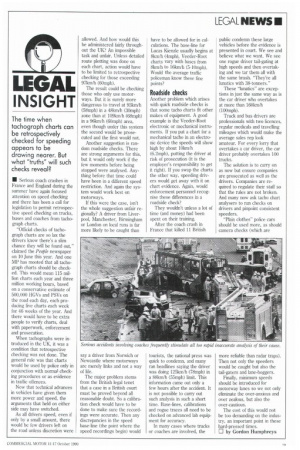LEGAL
Page 21

If you've noticed an error in this article please click here to report it so we can fix it.
INSIGHT
• Serious coach crashes in France and England during the summer have again focused attention on speed checking and there has been a call for Legislation to permit retrospective speed checking on trucks, buses and coaches from tachograph charts.
"Official checks of tachograph charts are so lax the drivers know there's a slim chance they will be found out," claimed the People newspaper on 10 June this year. And one MP has mooted that all tachograph charts should be checked. This would mean 115 million charts each year and three million working hours, based on a conservative estimate of 500,000 HGVs and PSVs on the road each day, each producing five charts each week for 46 weeks of the year. And there would have to be extra people to verify charts, deal with paperwork, enforcement and prosecution.
When tachographs were introduced in the UK, it was a condition that retrospective checking was not done. The general rule was that charts would be used by police only in conjunction with normal checking procedures or as evidence in traffic offences.
Now that technical advances in vehicles have given them more power and speed, the arguments that held on either side may have switched.
As all drivers speed, even if only by a small amount, there would be few drivers left on the road unless discretion were allowed. And how would this be administered fairly throughout the UK? An impossible task and unfair. Unless detailed route plotting was done on each chart, action would have to be limited to retrospective checking for those exceeding 97km/h (60mph).
The result could be checking those who only use motorways. But it is surely more dangerous to travel at 93km/h (58mph) in a 48km/h (30mph) zone than at 109km/h (68mph) in a 96km/h (60mph) area, even though under this system the second would be prosecuted and the first would not.
Another suggestion is random roadside checks. There are strong arguments for this, but it would only work if the few moments before being stopped were analysed. Anything before that time could have been in a different speed restriction. And again the system would work best on motorways.
If this were the case, isn't the whole suggestion unfair regionally? A driver from Liverpool, Manchester, Birmingham or London on local runs is far more likely to be caught than say a driver from Norwich or Newcastle where motorways are merely links and not a way of life.
The major problem stems from the British legal tenet that a case in a British court must be proved beyond all reasonable doubt. So a calibration check would have to be done to make sure the recordings were accurate. Then any discrepancies in the speed base-line (the point where the speed recordings begin) would have to be allowed for in calculations. The base-line for Lucas Kienzle usually begins at 8km/h (4mph), Veeder-Root charts vary with bases from 8km/li to 16km/h (5-10mph). Would the average traffic policeman know these fine points?
Another problem which arises with quick roadside checks is that some tacho charts fit other makes of equipment. A good example is the Veeder-Root electronic or mechanical instruments. If you put a chart for a mechanical tacho in an electronic device the speeds will show high by about 10krn/h (6.2mph), putting the driver at risk of prosecution (it is the employer's responsibility to get it right). If you swap the charts the other way, speeding drivers would get away with it on chart evidence, Again, would enforcement personnel recognise these differences in a roadside check?
They wouldn't unless a lot of time (and money) had been spent on their training.
After the coach crash in France that killed 11 British tourists, the national press was quick to condemn, and many ran headlines saying the driver was doing 125km/h (78mph) in a 88km/h (55mph) limit. This information came out only a few hours after the accident. It is not possible to carry out such analysis in such a short time. Base-lines, calibrations and rogue traces all need to be checked on advanced lab equipment for accuracy.
In many cases where trucks or coaches are involved, the
public condemn these large vehicles before the evidence is presented in court. We see and believe what we want. We see one rogue driver tail-gating at high speeds and then overtaking and we tar them all with the same brush. "They're all lunatics with 38-tormers."
These "lunatics" are exceptions in just the same way as is the car driver who overtakes at more than 160km/h (100mph).
Truck and bus drivers are professionals with two licences, regular medicals and travelling mileages which would make the average sales rep look amateur. For every lorry that overtakes a car driver, the car driver probably overtakes 100 trucks.
The solution is to carry on as now but ensure companies are prosecuted as well as the drivers. Companies are required to regulate their staff so that the rules are not broken. And many now ask tacho chart analysers to run checks on drivers and pinpoint consistent speeders.
"Plain clothes" police cars should be used more, as should camera checks (which are more reliable than radar traps). Then not only the speeders would be caught but also the tail-gaters and lane-hoggers.
Finally, minimum speeds should be introduced for motorway lanes so we not only eliminate the over-anxious and over zealous, but also the over-cautious.
The cost of this would not be too demanding on the industry, an important point in these hard-pressed times.
LI by Gordon Humphreys
























































































